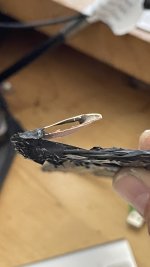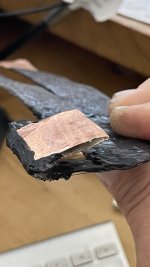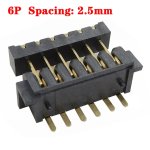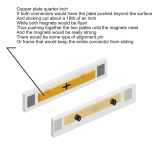Bobby June
1 W
I was wondering if these bus bar extensions are more resistant prone then I had originally thought.
BUS BAR CONNECTIONS
DID LARGE SURFACE-AREA SOLDERING FOOL MY THOUGHT OF PROPER FLOW?
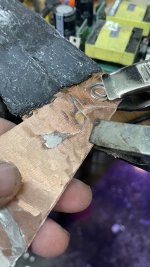
When two sheets of .25 are joined with the amount of solder (+flux) shown and with that degree of surface area,
• is there a large amount of resistance to be concerned with (I.e. heat/joint/connection failure or unplanned additional power-robbing resistance)
or
• does the surface area connection in comparison to the cross-section of the current path within the two sheets, in total, fall so far below the flat face-to-face offensive soldered joint that the solder joint becomes a non-issue? (My original thought)
———-
Additional concern with similar structure and connectivity
BUS BAR EXTENSIONS
HOW DOES THE THOUGHT OF 2 .15 COPPER STRIPS OF SHEETING ACTING AS PARALLEL BUS EXTENSIONS OCCASIONALLY JOINED WITH SOLDER SIT IN ONES MIND WHEN THINKING ABOUT FLOW/RESISTANCE?
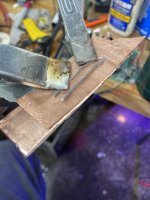
Since most of the copper used is .25 yet at the end of the build I then ran out and am left with .15 sheets, I am then forced to clamp and torch solder (see example of solder/surface area before joined above - and solder always drips out as if too much was applied as clamps close shut) two sheet of now what I considering ‘bus bar extensions’ as if they are just as good as a .25 -and- knowingly seeing that the solder + clamp smashing didn’t result in some vise-like lamination but as more or a two-layers in parallel with intermittent solder bonding. (And see a failed attempt to show gaps, which are there, here and there, below)
Am I creating a problem with ignorance in flow and resistance or lucky at a guess?
• creating a problem - These sheets are about 6-10” of intermittent .15 parallel sheets. Is this just a jumbled city street for the current to flow increasing resistance?
Or
• lucky guess - does the current see that, ‘hey, we’ve got above .25 in two lanes so all is good even though a couple 90 degree turns are made along the way” (my original thought)
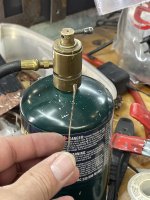
BUS BAR CONNECTIONS
DID LARGE SURFACE-AREA SOLDERING FOOL MY THOUGHT OF PROPER FLOW?

When two sheets of .25 are joined with the amount of solder (+flux) shown and with that degree of surface area,
• is there a large amount of resistance to be concerned with (I.e. heat/joint/connection failure or unplanned additional power-robbing resistance)
or
• does the surface area connection in comparison to the cross-section of the current path within the two sheets, in total, fall so far below the flat face-to-face offensive soldered joint that the solder joint becomes a non-issue? (My original thought)
———-
Additional concern with similar structure and connectivity
BUS BAR EXTENSIONS
HOW DOES THE THOUGHT OF 2 .15 COPPER STRIPS OF SHEETING ACTING AS PARALLEL BUS EXTENSIONS OCCASIONALLY JOINED WITH SOLDER SIT IN ONES MIND WHEN THINKING ABOUT FLOW/RESISTANCE?

Since most of the copper used is .25 yet at the end of the build I then ran out and am left with .15 sheets, I am then forced to clamp and torch solder (see example of solder/surface area before joined above - and solder always drips out as if too much was applied as clamps close shut) two sheet of now what I considering ‘bus bar extensions’ as if they are just as good as a .25 -and- knowingly seeing that the solder + clamp smashing didn’t result in some vise-like lamination but as more or a two-layers in parallel with intermittent solder bonding. (And see a failed attempt to show gaps, which are there, here and there, below)
Am I creating a problem with ignorance in flow and resistance or lucky at a guess?
• creating a problem - These sheets are about 6-10” of intermittent .15 parallel sheets. Is this just a jumbled city street for the current to flow increasing resistance?
Or
• lucky guess - does the current see that, ‘hey, we’ve got above .25 in two lanes so all is good even though a couple 90 degree turns are made along the way” (my original thought)




